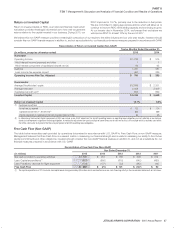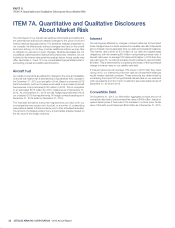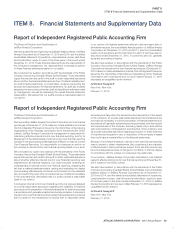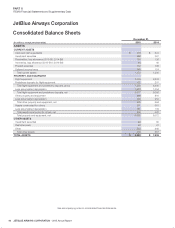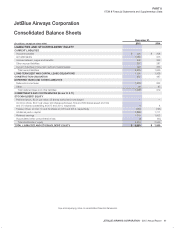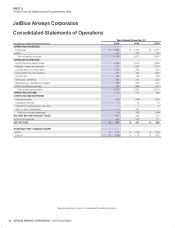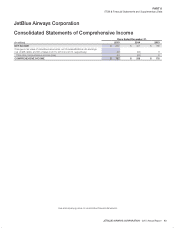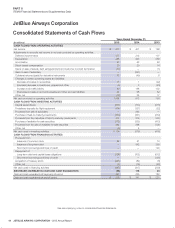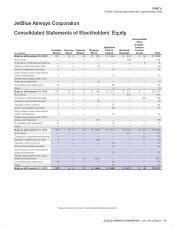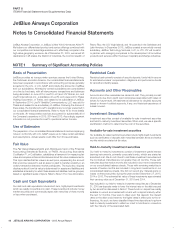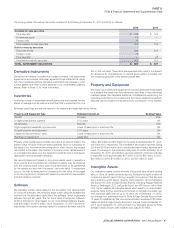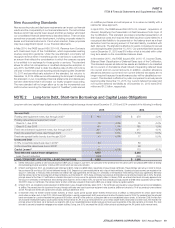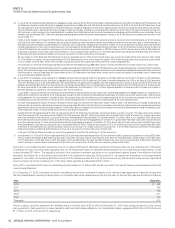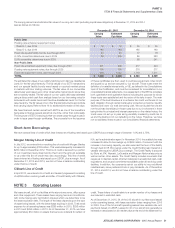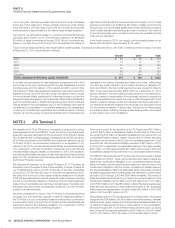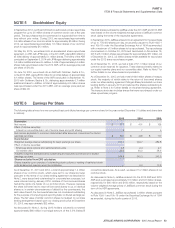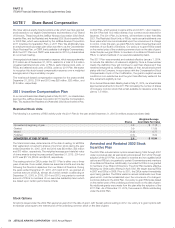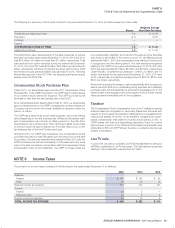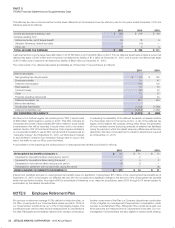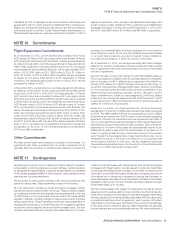JetBlue Airlines 2015 Annual Report Download - page 51
Download and view the complete annual report
Please find page 51 of the 2015 JetBlue Airlines annual report below. You can navigate through the pages in the report by either clicking on the pages listed below, or by using the keyword search tool below to find specific information within the annual report.
JETBLUE AIRWAYS CORPORATION-2015Annual Report 47
PART II
ITEM 8Financial Statements and Supplementary Data
The carrying values of investment securities consisted of the following at December 31, 2015 and 2014 (in millions):
2015 2014
Available-for-sale securities
Time deposits $ 125 $ 125
Commercial paper 55 —
Treasury bills 75 —
Total available-for-sale securities 255 125
Held-to-maturity securities
Corporate bonds 322 254
Treasury notes 30 —
Time deposits — 48
Total held-to-maturity securities 352 302
TOTAL INVESTMENT SECURITIES $ 607 $ 427
Derivative Instruments
Derivative instruments, including fuel hedge contracts, fuel basis swap
agreements and interest rate swap agreements are stated at fair value,
net of any collateral postings. Derivative instruments are included in other
current assets and other current liabilities in our consolidated balance
sheets. Refer to Note 12 for more information.
Inventories
Inventories consist of expendable aircraft spare parts and supplies that are
stated at average cost as well as aircraft fuel that is accounted for on a
first-in, first-out basis. These items are expensed when used or consumed.
An allowance for obsolescence on aircraft spare parts is provided over
the remaining useful life of the related aircraft fleet.
Property and Equipment
We record our property and equipment at cost and depreciate these assets
on a straight-line basis over their estimated useful lives to their estimated
residual values. We capitalize additions, modifications enhancing the
operating performance of our assets and the interest related to predelivery
deposits used to acquire new aircraft and the construction of our facilities.
Estimated useful lives and residual values for our property and equipment are as follows:
Property and Equipment Type Estimated Useful Life Residual Value
Aircraft 25 years 20%
In-flight entertainment systems 5-10 years 0%
Aircraft parts Fleet life 10%
Flight equipment leasehold improvements Lower of lease term or economic life 0%
Ground property and equipment 2-10 years 0%
Leasehold improvements—other Lower of lease term or economic life 0%
Buildings on leased land Lease term 0%
Property under capital leases is initially recorded at an amount equal to the
present value of future minimum lease payments which is computed on
the basis of our incremental borrowing rate or, when known, the interest
rate implicit in the lease. Amortization of property under capital leases is
on a straight-line basis over the expected useful life and is included in
depreciation and amortization expense.
We record impairment losses on long-lived assets used in operations
when events and circumstances indicate the assets may be impaired
and the undiscounted future cash flows estimated to be generated
by the assets are less than the assets’ net book value. If impairment
occurs, the loss is measured by comparing the fair value of the asset
to its carrying amount. Impairment losses are recorded in depreciation
and amortization expense.
Software
We capitalize certain costs related to the acquisition and development
of computer software. We amortize these costs using the straight-line
method over the estimated useful life of the software, which is generally
between five and ten years. The net book value of computer software,
which is included in other assets on our consolidated balance sheets,
was $93 million and $73 million as of December 31, 2015 and 2014,
respectively. Amortization expense related to computer software was $34
million, $39million and $18 million for the years ended December 31, 2015,
2014 and 2013, respectively. The increases in amortization expense during
2014 and 2015 are mainly due to accelerated amortization expense as a
result of a change in the expected useful lives of certain software. As of
December 31, 2015, amortization expense related to computer software
is expected to be approximately $27 million in 2016, $25 million in 2017,
$20 million in 2018, $14 million in 2019, and $3 million in 2020.
Intangible Assets
Our intangible assets consist primarily of acquired take-off and landing
slots, or Slots, at certain domestic airports. Slots are the rights to take-off
or land at a specific airport during a specific time period of the day and
are a means by which airport capacity and congestion can be managed.
We account for Slots at High Density Airports, including Reagan National
Airport in Washington, D.C., LaGuardia Airport, and JFK Airport, both in New
York City as indefinite life intangible assets which results in no amortization
expense. Slots at other airports are amortized on a straight-line basis over
their expected useful lives of up to 15 years. As of December 31, 2013,
we changed our estimated lives for Slots at High Density Airports from
15 years to indefinite life. We incurred amortization expense of $5 million
related to Slots at High Density Airports for the year ended December 31,
2013. As of December 31, 2015 and 2014 our intangible assets for Slots
at High Density Airports with indefinite lives was $139 million.


